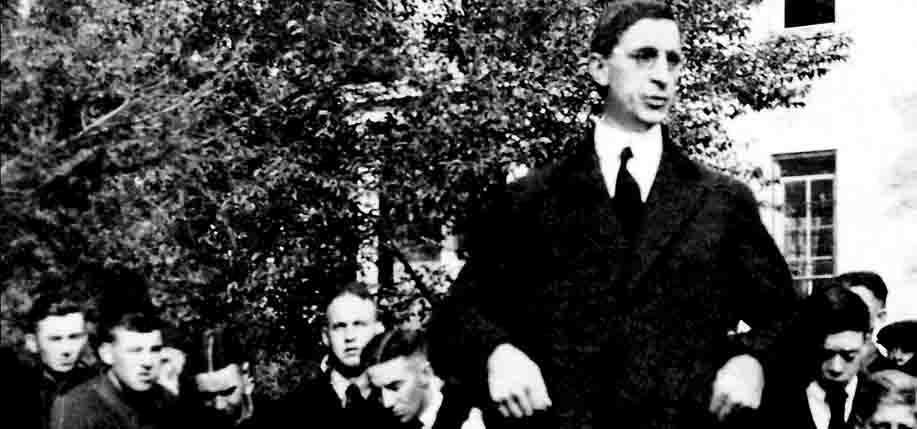Captured in May 1918 and imprisoned in Lincoln Prison, England, Eamon de Valera, Ireland’s future president, escaped in dramatic fashion on February 3, 1919. Fearing the propaganda boost his re-arrest would provide England, the IRA dispatched de Valera to the United States. His mission was to acquire official U.S. support for Irish independence, and raise funds. He traveled through the States visiting Irish groups, meeting politicians and collecting funds that totaled $6 million.
One visit took him to South Bend, Indiana, where he planted a “Tree of Liberty,” at Notre Dame University.
The Scholastic, the university’s student newspaper, reported that University President Fr. Burns, had invited de Valera to address the student body on Wednesday, October 15, 1919: “Elaborate preparations are being made at the University by the committees acting with the local branch of the Friends of Irish Freedom for the reception of the distinguished visitor. If the necessary arrangements can be made, the students will be asked to turn out en masse for a parade, and the school’s newly-organized band will be expected to add ‘tone’ to the reception.”
The following week’s edition counseled that “Notre Dame’s welcome should be worthy of the eminence of her guest.” And indeed it was. The Ave Maria newspaper reported on the visit thusly: “It was characteristically gracious of Dr. Eamon de Valera, ‘King of Ireland,’ as one youthful admirer calls him to assure the students of the University of Notre Dame that he would remember as ‘His happiest day in America’ the one on which he visited them. The address in which he made this statement evoked such applause as the eminent Irishman seldom hears, it was so spontaneous, continuous and uproarious. He was listened to with breathless attention – every one present seemingly eager to catch every word that fell from his lips. But his personality made even a deeper impression – his gravity when speaking of serious things, his reverence when referring to holy things. Few failed to observe how recollectedly he said Grace at table, and how thoroughly absorbed he seemed to be while kneeling before the Blessed Sacrament. A good as well as a great man, a leader who inspires the highest respect and the fullest confidence, is President Eamon de Valera.”
De Valera’s speech, subsequently published in The Scholastic, concerned Ireland’s favorable attitude to the League of Nations, the morality of the 1916 Rising, and the potential for peaceful political cooperation between Catholic and Protestant.
Writing in The Scholastic, T.J. Tobin commented: “Upon his arrival, Mr. de Valera received one of the greatest ovations that Notre Dame has ever accorded a visitor. After exchanging greetings with Very Rev. Provincial Morrissey and the members of the faculty, he proceeded to the Statue of Father Corby, at the foot of which he laid a wreath bearing the inscription “From Eamon de Valera in loving tribute to Father Corby who gave general absolution to the Irish Brigade at Gettysburg.” After he had spoken briefly upon the importance of the role played by Army chaplains, he was taken to the University Library and shown the Gaelic collection in which are the sword of General Meaghar and the flag of the Irish Brigade. From the Library he went to the center of the quadrangle and there planted a tree as a memorial of his visit.”
De Valera would return to Ireland in December 1920 and later lead the anti-Treaty forces in the Irish Civil War, during which he would again be arrested and imprisoned, on this occasion by his former comrades. His supporters appealed to Notre Dame “to use its influence to obtain immediate information regarding the present condition and whereabouts of the distinguished scholar and statesman its President and faculty took pride in honoring if for no other reason than to alleviate the suffering and anxiety of his sorrowing wife (or perhaps widow) and family and to join in the nationwide demand for his release, if still alive.”
On his release, de Valera became the dominant political figure in 20th-century Ireland, establishing Fianna Fáil, holding various political offices and authoring Ireland’s 1937 constitution. He ended his political career as President of Ireland, serving two terms from 1959 until 1973. He was also the Chancellor of the National University of Ireland from 1922 until 1975.
Sadly, visitors to Notre Dame seeking the tree planted by de Valera will look in vain. A mere week after the future Irish president’s departure, a student of “the Unionist persuasion” deracinated the tree and deposited it in one of the placid lakes flanking the famous grotto. (Notre Dame, then as now, was a politically diverse institution). The tree was never replanted – an oversight that continues to this day. However, his visit to Notre Dame on October 15, 1919 to garner support for an independent Irish republic, is also thought to have played a role in the university officially adopting the “Fighting Irish” nickname, which symbolized the underdog spirit of the striving immigrant Irish students and players. ♦
You can read more about the origins of the Notre Dame “Fighting Irish” moniker HERE.


I would love to help orchestrate or aid in a 100 anniversary replanting of the Tree
A question which has often been asked even by people like my father-A true Finna Faile supporter-why didn’t DeVelara himself go to England for the debate on Irish Independence? Another question often asked: What is the true and real ethnic background of Eamon DeValera’s ancestors? While I am totally familiar with Spanish surnames having spent a lot of time in Latin America and one semester at the University of Madrid, questions often have arised as to his true background! When he was born in New York it was not a period when Spanish Immigrants moved to the Big Apple! Does anbody have any new information on Eamon’s background?